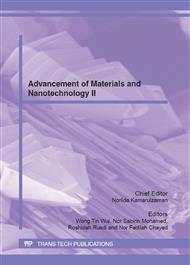p.359
p.367
p.373
p.379
p.387
p.393
p.401
p.405
p.410
Fabrication of Dye Sensitized Solar Cell Based on TiO2 Nanoparticles and Chlorophyll from Pandan Leaf as Active Layer
Abstract:
Dye sensitized solar cell (DSSC) is a new class of low-cost solar cell, that belongs to third generation solar cells in thin film based. It is based on a semiconductor formed between a photo-sensitized anode and an electrolyte, known as photoelectrochemical system. A lot of research has been conducted due to their interesting potential for low-cost, lightweight, disposable and having cell efficiency up to 10%. This paper reports the fabrication of dye sensitized solar cells using TiO2 nanoparticles and chlorophyll as active layer. TiO2 nanoparticles were prepared by sol-gel method while the chlorophyll was extracted from Pandanus amaryllifolius (Pandan leaf). TiO2 film was prepared on ITO coated glass using dip coating technique and then immersed overnight in the chlorophyll solution. An electrolyte solution composed of PC-LiClO4 was injected into the cell before sealed using glass that was coated with Pt as top electrode. An active area of 4.48 cm2 was fabricated by black masking the front side. The performance of the device was studied by observing the current-voltage characteristics of the device in dark at ambient temperature and under illumination of 100 mW/cm2 light. It was found that the device showed rectifier property in the dark and able to generate electrical current under light.
Info:
Periodical:
Pages:
405-409
Citation:
Online since:
July 2012
Authors:
Price:
Сopyright:
© 2012 Trans Tech Publications Ltd. All Rights Reserved
Share:
Citation:



